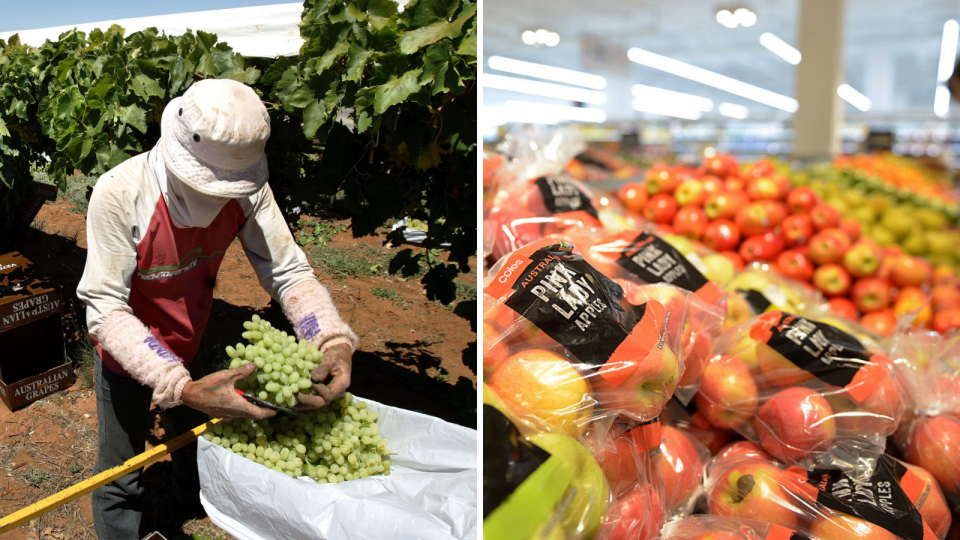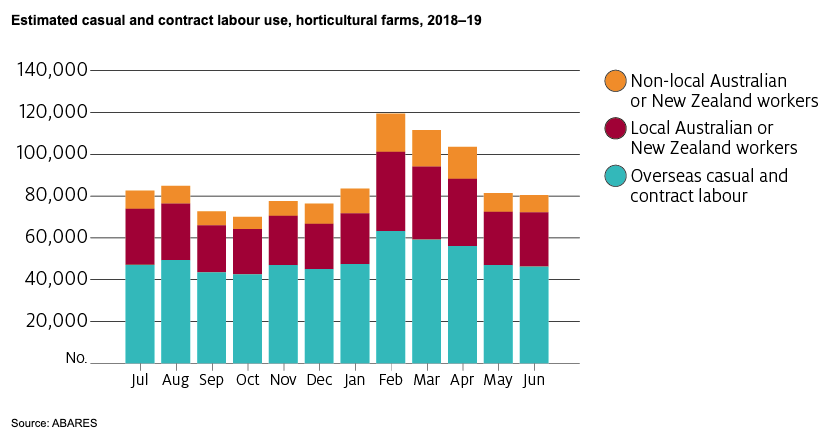Supermarket warning: Fruit, veggie prices to rise 15-25%

The prices of summer vegetables, stone fruit, apples, pears and grapes are expected to jump by as much as 25 per cent next year, driven by the Covid-19 travel ban, new data has revealed.
According to the Department of Agriculture’s December 2020 commodities report, an anticipated drop in production is expected to push up consumer prices, with horticulture produce in particular hardest-hit.
“Prices of summer vegetables, stone fruit, pome fruit and table grapes are forecast to rise by between 15 per cent and 25 per cent,” the report stated.
Overseas workers, such as working holiday-makers and backpackers, typically make up the bulk of the farm workforce.

In February 2019, during peak harvest season, the number of casual and contract employees from abroad rose to an average of 63,300 people per month. This is up from a “relatively stable” figure of around 46,000 people per month between July and January.
Working holiday-makers are able to have their visa extended for a second or third year, but must work in specific occupations, like farm work in regional areas for a certain amount of time.
Meanwhile, the Seasonal Worker Programme brings in Pacific Island workers to Australia to work in the agriculture sector.
But in the 12 months to September this year, the number of people in Australia on these types of visas fell by 48 per cent.
While most farmers are currently managing the overseas worker shortage, NSW Farmers Horticulture Committee chair Guy Gaeta said there remained uncertainty about next year’s fruit and vegetable.
“There is no doubt that some sectors such as berries are experiencing difficulties in getting pickers, but most of the growers I talk too are getting their crops picked,” he told Yahoo Finance.
“The crunch time will be in March April next year if international borders are still not open.
“Backpackers are vital for our sector and if they are not able to get here, crops like citrus, stone fruit and vegetables may not be able to picked to their full capacity.”
Aussie workers won’t meet shortfall despite high unemployment
To predict price rises, the Australian Bureau of Agricultural and Resource Economics and Sciences (ABARES) modelled its forecasts on an assumed 50 per cent drop in overseas labour for the remainder 2020-21 financial year.
The Federal Government has put in place several initiatives to incentivise Australians to undertake farm work, including JobMaker as well as a $6,000 relocation scheme which covers accommodation costs and travel costs.
Additionally, employers and producers also have the option of paying higher wages and creating better working conditions, with some employers offering free accommodation, the report noted.
Thousands of Australians remain out of work, with the national unemployment rate currently at 7 per cent.
But despite these efforts, Australian workers have not been responsive to this.
“High unemployment among domestic workers in the past has not resulted in a strong uptake of horticultural work. This suggests that unemployed domestic workers will not meet the present shortfall in overseas workers,” the report said.
Which areas will be hardest-hit?
Different types of produce will experience labor shortage impacts differently, with some regions to fare better than others.
“The producers best placed to secure the labour they require appear to be those in North Queensland and Coffs Harbour–Grafton in northern New South Wales,” the report said.
This region typically produces citrus and vegetables, while Coffs Harbour–Grafton produces berries, vegetable, stone fruit and citrus.
“They get early access to the limited supply of overseas labour and have the opportunity to offer better pay and conditions to keep overseas labour during their peak harvest period,” the report said.
Meanwhile, Bunbury and South East Tasmania producers are at greatest risk of not being able to secure workers, impacting stone fruit, apples, and pears.
“A 50 per cent cut in the supply of overseas labour to producers in these regions would mean a cut to the casual labour force of around 43 per cent in Bunbury and around 47 per cent in South East Tasmania.
“Both regions are also geographically isolated from most other regions that attract overseas labour.”
Will higher prices stop Aussies buying fruits and veggies?
According to ABARES, it’s not likely.
In fact, the overall value of horticultural production is actually slated to increase by 5 per cent to $12.6 billion in 2020-21.
“Australian consumers generally do not significantly reduce purchases of fresh produce when prices rise,” the report said.
Part of the reason why is because Australia doesn’t have many imported products to substitute. Other factors like biosecurity protections, transport costs and seasonal availability also contribute to this.
“Additionally, most household purchases of fresh produce generally make up a small share of household budgets. This provides more scope to pay higher prices for these products.”
Want to hear Australian influencers reveal their best finance tips? Join the Broke Millennials Club on Facebook, and receive one hot tip per day in December.
And if you want 2021 to be your best (financial) year yet, follow Yahoo Finance on Facebook, LinkedIn, Instagram and Twitter. Subscribe to the free Fully Briefed daily newsletter here.

 Yahoo Finance
Yahoo Finance 
